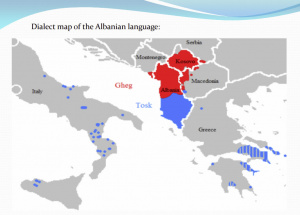Language/Tosk-albanian/Culture/Landmarks-and-Monuments
| ◀️ Geography of Albania — Previous Lesson | Next Lesson — Famous Albanian Writers and Poets ▶️ |
Introduction: Welcome to the lesson on Tosk Albanian culture, specifically focusing on landmarks and monuments in Albania. In this lesson, we will explore the significance of these landmarks and monuments, as well as their cultural and historical importance. By the end of this lesson, you will have a deeper understanding of Albania's rich heritage and the role these landmarks and monuments play in its culture. Let's begin!
Importance of Landmarks and Monuments[edit | edit source]
Landmarks and monuments hold great significance in the history and culture of a country. They serve as symbols of national pride, commemorate important events, and represent the shared identity of a nation. In Albania, landmarks and monuments have played a crucial role in preserving the country's cultural heritage and showcasing its historical achievements. By studying these landmarks and monuments, you will gain insight into the history, architecture, and cultural values of Albania.
Historical and Cultural Significance[edit | edit source]
Albania is home to a wide range of landmarks and monuments that reflect its diverse history and cultural heritage. From ancient ruins to modern architectural marvels, each landmark and monument has its own unique story to tell. Let's explore some of the most notable ones:
Butrint[edit | edit source]
Located in the southern part of Albania, Butrint is an ancient city that dates back to the 7th century BC. It is a UNESCO World Heritage Site and showcases the remnants of various civilizations that once thrived in the region, including the Greeks, Romans, Byzantines, and Venetians. The ancient ruins of Butrint provide valuable insights into the architectural and cultural history of Albania.
Berat Castle[edit | edit source]
Berat Castle, also known as the "City of a Thousand Windows," is a medieval fortress located in the city of Berat. It is one of the best-preserved castles in Albania and offers panoramic views of the surrounding landscape. The castle is a testament to the country's rich medieval history and is a popular tourist destination.
Skanderbeg Square[edit | edit source]
Skanderbeg Square is the main square in the capital city of Tirana. It is named after the national hero of Albania, Gjergj Kastrioti Skanderbeg, who led the resistance against the Ottoman Empire in the 15th century. The square is adorned with statues, fountains, and important government buildings, making it a focal point for political and cultural activities in Albania.
National Museum of History[edit | edit source]
The National Museum of History, located in Tirana, is the largest museum in Albania. It houses a vast collection of artifacts, documents, and artworks that depict the country's history from prehistoric times to the present day. The museum provides visitors with a comprehensive understanding of Albania's cultural, political, and social evolution.
Et'hem Bey Mosque[edit | edit source]
The Et'hem Bey Mosque, situated in the heart of Tirana, is one of the oldest mosques in Albania. It was built in the early 19th century and is known for its beautiful frescoes and intricate architectural design. The mosque serves as a symbol of religious tolerance and is open to both locals and tourists.
Regional Variations and Cultural Facts[edit | edit source]
While many landmarks and monuments are celebrated throughout Albania, it is important to note that there may be regional variations in their usage and understanding. Different regions may have their own unique landmarks and monuments that hold particular significance for the local communities. For example, in the city of Shkodra, the Rozafa Castle is a prominent landmark that represents the city's rich history and resilience.
Furthermore, the cultural significance of these landmarks and monuments extends beyond their historical value. They often serve as gathering places for festivals, celebrations, and cultural events. For instance, Skanderbeg Square in Tirana is a popular venue for concerts, parades, and public gatherings, showcasing the vibrant cultural life of the capital city.
Exercises[edit | edit source]
Now that we have explored the importance and cultural significance of landmarks and monuments in Albania, let's test your knowledge with a few exercises:
Exercise 1: Match the following landmarks with their descriptions: 1. Butrint 2. Berat Castle 3. Skanderbeg Square 4. National Museum of History 5. Et'hem Bey Mosque
a. Medieval fortress in Berat b. Ancient city with ruins from various civilizations c. Main square in Tirana d. Largest museum in Albania e. Oldest mosque in Tirana
Solution: 1. b 2. a 3. c 4. d 5. e
Exercise 2: True or False: Skanderbeg Square is named after a national hero.
Solution: True
Exercise 3: What is the significance of Rozafa Castle in Shkodra?
Solution: Rozafa Castle represents the rich history and resilience of the city of Shkodra.
Conclusion[edit | edit source]
Landmarks and monuments play a crucial role in preserving and showcasing the cultural heritage of Albania. They provide valuable insights into the country's history, architecture, and cultural values. By studying these landmarks and monuments, you will deepen your understanding of Albania's rich heritage and develop a greater appreciation for its cultural significance. Keep exploring and learning about the diverse landmarks and monuments that make Albania a unique and fascinating country.
Other Lessons[edit | edit source]
- Musical Traditions
- Geography of Albania
- History
- How to communicate
- Leisure Activities
- Albania Timeline
- Famous Albanian Writers and Poets
- History of Albania
- Popular Sports
| ◀️ Geography of Albania — Previous Lesson | Next Lesson — Famous Albanian Writers and Poets ▶️ |

